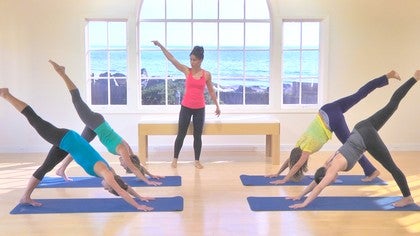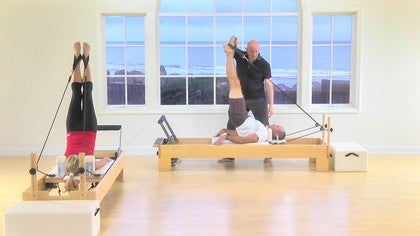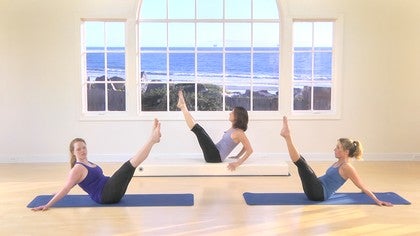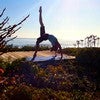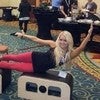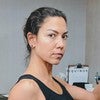Description
About This Video
Transcript
Read Full Transcript
Good to be here again on Pilates Anytime, and to get it started with a reformer class. So we're just going to work on a whole body movement experience, sort of head to toe, at an intermediate-- maybe a few advanced things, but more intermediate level. And just looking at how we can make the exercises a little bit easier as we go into the intermediate repertoire. So we're going to start on your backs, we'll start with some foot work. And adjust yourself so you feel comfortable there with the head rest.
We're going to find ways to take out some of the sting of the intermediate and advanced Pilates work. Starting-- let's start on your heels, actually. Just do a nice, simple warm up and sort of discover our bodies. Pressing out and in on your own time. And what I want you to do, is I want you to allow yourself the ability to even make a few mistakes in the beginning as you're pressing out with your feet, and just sort of notice what your body wants to do.
And then as you go along, start telling your body what you want it to do. A little difference, isn't there, between what it wants to do, and what you want to do when you start off. So think of a big smile across the front of your chest to your shoulders. The back of the neck lengthening. And as you exhale, feel the ribcage starting to descend.
Not necessarily by drawing it down, but just feel like gravity is on it. So, a sandbag or something, sort of taking it down and opening that up. Feel the back of the spine lengthening, the pelvis nice and open, and the hips lubricating. With that being said, let's go ahead and turn the knees and hips out. So right where your feet are, just turn out nicely.
Yep. And pressing out. Keep going. Nice and easy. And again, just changing the orientation a little bit.
And we'll just play with a quick foot warm up, so we wake up our body, get the blood pumping. Four more of those. And take it out nice and wide. Really taking advantage of the foot bar, take those feet as wide as you can, and keep going. Keep running with it.
Good. Good, good. And on this one, notice how the sit bone is going to be your driver. So think of the sit bones widening as you come down, and narrowing to come up. And see if you could almost get out of the legs and let the pelvis do the work.
So the pelvis is going to be widening and narrowing. And turn those knees up towards the ceiling. Staying out wide in the bar. Just keep going. We're just changing the angles on the muscles around the hip, getting those rotators to relax, they're going to allow us to do some really cool stuff.
And then allow the knees to turn in. Yep, that's it. Beautiful. And with that now, meaningful circles. So what I mean by the knee circles, is just spin on the heels.
Nice circles all the way around. And feel the socket deepening, or sinking into the sockets. The femur heads dropping in. Two more, and then change the direction. If you feel a little ratchety going around, a lot of times those are muscles that are getting in the way.
So allow them to relax, and just think of that ball and socket joint, smooth, lubricated, the weight of the springs is helping you out. Last one. And bring it on in. Come all the way on to the toes. Feet together, knees together, ankles together.
Press out with your legs. Send the heels underneath the bar, and just stay there for a second. This is a good chance to sort of wake up the whole posterior side, what I often call the fascial hammock. So if I had a hook on the head of Andy, and on his heels, and he was the hammock between two coconut trees, take in a deep breath, exhale, and let the organs and the bones settle into that hammock. And the heels drop down even a little bit further.
So you can feel that whole tension on the back side. Now to bring the carriage back home, what I want you to do is initiate by bending the knees, not the ankles. So let the ankles stay in that dorsi flex position to bring the carriage home. Then send the heels underneath to push it back out. You got it.
Let's repeat that. Knees bring the carriage home, heels press the carriage out. You've got it. Let's do three more of those. And as you press the heels out, feel that hammock sensation, and the organs dropping into that fabric in your body.
You can really feel it sink into place. Last one. Now stay there, rise up onto the toes. Yep, good. And keep the ankles pointing as you bend the knees in.
So, a forced arch. The heels are going to rise when you come in and press back out. Ankles rise and press back out. Good. That's it.
Let's pick up the pace a little bit with that. Put a little vigor in it now. That's vigor, not vinegar. There we go, nice. And we're getting ready go right into some running.
So you're going to go right into running, alternating the legs. So press out and alternate now. And again, nice and brisk. Feel the weight, nice and equal between the feet. Between the knees, the hips, all the way up through the body.
And as you feel more and more comfortable, you keep that pelvis quiet, you can go a little bit faster, a little brisker, a little fuller range. If you feel that you lose that little bit, or one leg's asymmetrical, slow it down and recapture the control. Nice. And let's do two more of those. Beautiful.
And come all the way down. Now, go back onto your heels on the bar, come all the way down, heels onto the bar. Press out with your legs, and leave the legs out straight now. And just with your ankles, you're going to point the toes over and pull the toes back. Just like that.
So we're just sort of opening, working through the foot, getting a nice stretch along the dorsum, opening up the intrinsics of the foot. And feel like you're actually massaging something underneath your feet as you roll it over. Grab it. And reaching back. And grab.
And reach back. And then alternate it. So you're going to take right foot down, left foot up, and alternate. Just working it through the ankle and the foot. Massaging through the feet.
Really feeling the toes even spreading as you pull them back, and pointing as you push them down. See if you can find that, working through that foot. We don't get into that foot enough. And waking that foot up. This is where all of our sensories end.
It's where our proprioception begins. And standing. We are standing animals, not sitting animals. Contrary to the last 100 years. And relax.
Come on down. Beautiful. What I want to do now is just a little single leg work. So we're going to go back onto the ball of the right foot. And keep this leg just up like this.
And let's let that ankle drop, just into a relaxed position. Good. And press out. Stay out there. Good.
Now from there, straighten out that left leg as best you can towards the ceiling. OK? Now from there, take that left leg down, and just beat the bar. And bring it back up, and then let the right knee bring you back in. So that's going to be the first part.
Keep the knees straight. So press out, beat the leg down. Back up, bend in. That's it. And out.
And beat. And up. And in. And out. And beat.
And up. And in. Two more times. Out. Beat.
Up. And in. Last one. Out. Beat.
Up. And let's come in, switching legs. So left foot down. That's right. Bring the right leg up.
Press out. Straighten the leg. Beat the leg. Nice and slow, know what we're doing, set the pattern. Bend the left knee in.
And we reach out. And beat. And up. And in. And out.
Beat. Up. And in. Press out. Beat.
Up. And in. Press out. Beat. Up and in.
And relax. Now, we'll come back to this a little bit later, but we set the pattern for it now. OK? Let's go right into some bridging, and I want to start with the feet together on the heels. Now, if you want to make it a little more challenging, you can go onto the balls of the feet.
I tell people this is the difference between a level two and a level three. And we're just going to do a simple bridge. So head rests are down if they're not down already, and rolling up through that spine. And let's take advantage of the 24 vertebrae, at least 15 of them, and feel them dropping down. Create that space as we open up the spine all the way down.
Good. And with your breath helping you articulating that spine up. Feel those knees reaching a little bit, giving us that length. Feel the sternum softening, dropping down. The ribs reaching to the back, opening like an accordion towards the mat.
Let's do two more of those at your own pace. Feel that articulation. For that length, let's keep this here. Drop sternum down first. Andy, let it go.
Let it go. That's it. That's what I want. Ribs, ribs, ribs, opening, opening, opening. Keep the length.
Beautiful. Good. Now, this time we're going to roll up. We'll drop down just a little bit, and we're going to wake up a little more of the segmental movement, because we need it. And we're going to slide the pelvis to the right and to the left.
So it's actually going to be a translation through the spine, right? Come back to center, drop down another centimeter, let's translate right to left. All right? Same thing. And think more about, rather than rotating, think really like sliding.
Like you're on a skateboard. Side to side. Drop down another centimeter, and repeat. That's it, right there. Good.
We're going to do one more those down and up. Try to see if you can get five to 10 repetitions, side to side. It's interesting, because sometimes you can feel a little manipulation in your back. You can feel muscles and be like, oh, I don't want to go there to the right on that side. It's OK.
Just sort of work with it, be gentle, and repeat it. Because what's happening is we want segmental movement, or we don't have control. If you're just a big block of vertebrae, there's no control over the movement. So we're trying to find that movement. Last one, nice and easy.
The more refined it is, the better. That's it. How are we doing, OK? Feel good, like the spine's starting to wake up, muscles starting to relax. Juices starting to flow inside the vertebrae and the facets.
That looks much better. There we go, good. OK. Come all way down on this last one. This time, feet nice and close together.
We're going to go up into a bridge. Drop the sternum down just a little bit, so that you're not arching your back. The sternum's down. Press the legs out all the way. Good.
And bring it back in. Keeping the bottom up. Let's just do four of those, nice and easy. Pressing out. Just like foot work, and in.
Pressing out. And looking for the relationship through the knees. The knees are moving, the hips actually are not moving. So the pelvis will rise and fall as the knees straighten out and bend. That make sense?
So now, from here, taking the leg out, legs are pressed out. Take your left leg and bend it. All right? Coming off of the legs. We're going here.
Remember what we did before, right? So we're going to straighten this leg out. We're going to do a beat. And up. And bend the knee in.
So it's the same thing. And out. And beat. And up. And in.
And out. And beat. And up. And in. The range of motion can change a little bit if it's more challenging.
That's OK. Don't have to press all the way out, don't have to let the leg all the way up. And last one. Come on in, bring that leg down. Keep the bottom up.
Bring the right leg up this time. Straighten the leg up. Press out. And beat. And up.
And knee. Bend in. Press out. And beat. And up.
Knee in. And the whole time we're trying to keep that pelvis nice and quiet, all right? Nothing in it so hard. Last one. And beat.
And in. And come on in. Roll down through your spine, feet come down, just take a little rest. You ready to add one more variable to that? Yes.
OK. So, let's do it-- let's do it dry, without being up in the bridge position. So what we're going to do is, we're going to talk about doing a circle. So when you beat the leg, you'll come up, and then you'll do a circle with the leg in that starting position. And then go again.
All right? So I'll call it out. But it's after the beat. Comes up. Circle out and around.
Back into that position. Yeah. OK? So let's bridge up. We're going to take that right leg up towards the ceiling.
We're going to press out the left leg. That's where the beat occurs. Nice and slow. And up. And the circle happens there.
And then the knee bends in. So let's press out. And beat. And circle. And in.
Press out. And beat. And circle. And in. Feel the rhythm of it.
And out. And beat. And circle. And in. There's a little pause there.
Out. And beat. And circle. Finish that circle. And in.
Last one, here we go. And reach. Keep that length. And beat. And circle.
And in. Switch legs. Nice job. Take that left leg up. Right?
And the whole idea here is we're challenging the rotatory force. So bottoms up. Get the bridge up there Andy, there you go. Left leg up. You got it.
Press out. And beat. Slow it down. Circle out and around. And knee in.
Let's repeat that. So we press out. And beat. And circle. And in.
That's right. And out. And beat. And circle. For that pause after the circle, that nice length.
And in. Good. And out. And beat. And circle.
And in. Last one. And out. And beat. And circle.
Little pause there for that organization. And in. Bring the foot down to the bar. Roll down through your spine. Beautiful job.
OK. So now what we're going to do, is you're going to set your legs over the top of the bar, like this. Yep. Raise your hands towards the ceiling. And on an exhalation, roll up into a seated position.
You've got it. Good. And change your springs to a red and a blue for you. Just right where you're sitting. And two reds for you.
Yeah? And we're going to go into feet in straps. Just roll back down. Grab your straps. Press out on the foot bar, slip your feet into the straps.
Meet me at 45 degrees for lunge. It's really important that we know where 45 degrees is, because a lot of the Pilates apparatus and positions are orientated towards that 45 degrees. So if we were at zero degrees, we'd be parallel with the floor. And if we were 90 degrees, we'd be parallel with the walls. So 45 degrees is somewhere right in the middle.
And the way that should feel to us-- relax a little bit there-- is that we can just rest into the 45 degree angle. Can you feel that? So you have weight there. Just let it happen. OK?
That's our safe spot. Very little abdominal work, very little back work has to happen. And we're going to pass through that zone. So what happens is, as the leg comes up the back musculature and fascia have to tighten up a little bit to keep the bottom from rolling up. You come back down, it lessens, lessens, lessens, you come to the sweet spot, 45.
And then the anterior structures have to become little more tense as the legs go down in the fight of gravity. OK? So that's what we're doing. Simple feet in straps. You also can adjust your head if you want to bring your head rest up at all right now, it's fine.
Feet coming down. Feet coming up. Now in the breath pattern, I'm not a fanatic about the rule of the breath. I tend to use it more as a tool. And so if I see little rectus poofus, or I see the back popping up, or I see you having a hard time, I will use an exhalation.
But I will gear that exhalation towards the ribs drawing down with the exhalation, not just a sip and puff. And challenge yourself to get down as low as you can without the back jumping up, or without losing that nice position of the pelvis in space. And I think that's probably one of the most important things we can do, is to get the length across the front of the hips. Because we have become such a sedentary species, and we need to spend more time standing. Because we get so tight here, we often forget about it, and it pulls our spine into an anterior sheer force.
And that leads to a ton of pathology in our backs. So the more open we are across the front of our hips, and the more stiffness we have in our abdominal wall when we do that, the better. And notice as the leg goes down lower, more and more control is needed in the abdominal wall. That looked actually very engaged there, that was nice organization, Andy. OK.
So let's go right into our circles. And just kind of let those legs come up. And out. And down. And together.
Just nice circles. And we'll do about six in each direction. Doesn't matter. You got it. And down.
And together. Now, in the hip circles, sometimes we use the cue of reaching the legs out. And I want you to think of sinking the hips in. We actually get better range of motion and more relaxation in the muscles when we feel like the hip joint is actually sinking in to the socket, all the way around. Come around, sweep it, and feel that sinking in to the socket.
There you go, good. Feel that weight. Same thing. Feel that weight into the hip. Circle it out.
I'll follow you. Feel the hip socket. There it is. That's what I want you to emulate, right there. Feel that sinking.
Good. And let's go the other direction. So switch the circle. Again, as you come around that edge, feel the hips sinking in. Right?
The straps are pulling in to the socket. Let them pull in to the socket, that's right. You're thinking of lubricating those joints. Now, with that being said, let's go to 45 degrees again. Meet me at 45.
Good. We should make that a-- like a cafe, or a restaurant for Pilates studios. It's at 45 degrees. 45 degrees, all right. So from here, let's go into a little bit of squatting activity with the straps.
So you're going to bend your knees in towards your chest, and press back out like a frog. A pre-frog. Just nice and simple. Yeah? And feel the connection between-- you guys are doing a great job keeping that connection between those heels.
That's the energy drawing out. And think more of the thighs being magnets towards each other than necessarily reaching them away. Feel the energy between them, yeah? And feel them separating as if there's energy pulling together, even though you're taking them apart. Feel that magnetic energy there.
And now go right into a full frog. So you're going to plie in. You're going to bend the knees. From there the carriage stays still. Reach the legs out.
Good. Now the carriage moves. You sweep the legs together. And plie in. And open.
And draw. And in. And out. And draw together. Good.
One more time. And in. And out. And draw. Now leave the legs there.
Just reverse it. Open the legs. Carriage stays still. Bring those heels together. And press them out.
And open. Heels come together. Feel the sit bones working, and press them out. And open. Heels come together.
Press them out. Last one. Open. Heels come together. And press out.
Going right into walking on the ceiling, all right? So one knee bends. Keep the tension the same on both. Push them back to 45 degrees. Bend the right.
That's it. And out. And this is sort of like rubbing your belly and patting your head at the same time. You're just trying to keep the tension on the straps the same. So notice, I'm going to keep this strap over the shin.
Mhm. So it's going to have to bend in a little bit deeper. There you go. Press it back to 45. And alternate.
Find that shin strap. It's going to stay over the shin. Good. And out. And there it is, good.
Now we can take that and go into a 45 degree angle out to the side, which I call the prodigal son. Some call it Peter Pan. But you bend one knee. The same thing, going out to the side. Sort of like Peter Pan flying through the air.
All right? That's it. Good. And switch. And bring them together.
So just a little more coordination and choreography. And feeling the challenge a little bit of what's going on in the pelvis. How does that pelvis handle the two different legs going in different loads into the pelvis. All right. One more time to each side.
Head rest needs to be down now, because we're going to go into a long spine. All right. So we warmed the spine up a little bit already. Hands are down to the side. We pike first at the hips.
And then we peel up. Keep the projection though, a feeling that's away. That's what's long about it. So there's a little bit of a-- right there. That's why-- do you feel how that engaged?
Now from here, keeping that same relation of the pelvis, start lowering through the heel. Keep pushing the feet down, right on the edge. I want you right on the edge of where the legs feel like they are going to drop down. And then you are going to do a little circle. And again.
Pike. Peel. Yeah? Feel that edge. Good, good, good.
Coming down. Reach for me. Reach for me. Right on the edge. Right there.
Soften that spine. Beautiful. And down. And small circle. And one more time with long spine.
And open the legs this time a little bit. There you go. Push them away from you. Push it away. Feel the legs reaching.
Reach those hips. Reach those hips. Yes. Right there. Reach, reach, reach.
That's what's long about it. That's what's long about it. And sweep. Good. OK.
So now let's go right into our short spine. OK? Similar prep. Pike and peel. Up we go, onto the shoulders.
Good. And give me a little more. You can come up a little bit higher. Right there. Now let the knees soften towards the ears.
That's it. Feet, I like to keep the feet still in space, and roll the bottom away until you feel the tension in the back of the hamstrings. When you get there, now bring the heels to the bottom, and press out. Nice. Good.
And pike. And peel. And plie. Feet stay still. Unpeel.
Feel that length. Unpeel. And press. And reach. [LAUGHTER] Just like an onion.
You peel and unpeel an onion. [LAUGHTER] That's a little inside joke in Pilates Anytime, watch my workshop and learn how to unpeel an onion. And reach that through. Feel that length. Feel that length, that opening, that neural mobilization.
Excellent. And reach out. Last one. This time while you're up, take those hands up to the ceiling. Control the balance.
That's right. And now bend the knees towards the ears. And try to keep that internal work working. Like you have a handle on your sit bones as you roll down away, feet stay still in space. Bring the heels down to marry, and press out.
Good. All right. Legs out at 45 degrees. Roll your head, neck, and shoulders up to the base of the shoulder blade. Hands to the side.
Take in a deep breath. And here we go with some 100s. And in. And out. And in.
Nice, deep breaths. This is great because the springs actually are helping us. They're holding our legs up, so we can get the feel of what it's like to really have those legs and do full complete breaths while we're working on this. And what I want you to feel, is feel that breath expanding back here. That's-- ah, there we go.
Kristi's already warmed up. I can feel her glistening. This is good. She's sweating more than Andy is. All right.
You've got two more breaths. And in. And out. And last one. And exhale.
Very good. Roll down. Bring your knees in towards your chest. And switch your hands right into those feet loops. Legs stay at 90 degrees.
Going into a little bit of arm art. So again, organize the pelvis and the knees and the spine. Yep, good. And arms are up at the ceiling, and we're going to take those arms down to the side. Simple arm arc.
Now, really important in the arm arc is making sure that we don't sublux forward with the shoulders. We come down. So that's the big smile across the shoulders that has to take place. And I'm going to have you go down just a little bit less. There.
Good. Can you feel the difference? I just want to keep this nice and open here. I don't want to feel that shoulder blade, the shoulder head coming forward. Good.
And let's go right into circles now that we understand that. So circle out. And down and around. Good. Now different from the hip, the shoulder does need to reach out.
So feel yourself reaching and pushing into those straps as you do your circle, for that full engagement. Almost as if the shoulder blade itself is moving around to keep the connection with the arm. Can you feel that? That connection? Beautiful.
And reverse that circle. Go the other way. That's it. And we'll play a little bit of coordination here that we call cheerleader. So the hands are going to come down to your side, all right?
And the right arm is going to go up. Left arm goes out. And then bring them down to the side. And then switch. Right arm goes up.
Left arm goes out. And down to the side. And again, alternating. And down to the side. And again, up.
And down to the side. Stay down to the side. Now we're going to do a full circle with it. So we're going to have left arm goes up. Right arm goes out.
And then we're going to do the circle over. And bring it down. So we're going to just keep doing that. Circle. Around.
You got it. And now you've got to go ra, ra, shish koom ba, kick 'em in the right knee, kick 'em in the left knee, kick 'em in the-- we need a touchdown. A touchdown. I don't know if that's inappropriate on Pilates Anytime. I don't think I said any bad words.
Did you reverse the direction yet? No. [LAUGHTER] This is rubbing the belly and patting the head. Give yourselves a little try there on that. We're going to go into coordination on the next ones.
So when you finish the last two of these, we're going to bring the hands down to the side. Yep. And we're going to bend the elbows up into a tricep bend position. Yep. Head and shoulders are going to roll up.
Right? And this we're going to do instead of a full 100s in this position. Is we're going to reach the legs out, and arms out. We beat the legs. Knees come in.
Elbows come in. Body stays up the whole time. Here we go. And reach. And beat.
And knees in. Hands in. And reach. And beat. Knees in.
Elbows in. And reach. And beat. Knees in. Elbows in.
And reach. And beat. Knees in. Elbows in. Last time.
Reach. And beat. Knees in. Elbows in. And relax.
Set your straps down. Set your legs over the bar. Bring those hands above your chest, and roll yourself up off of the machine. Beautiful. Oh.
There we go. This is OK. We're going to go into knee stretch. So we're going to swing the legs off. And I sort of like to keep the springs right where they are.
So we're good, spring. If you feel like it's too easy for you, you want to add a little bit more, you're welcome to put on another yellow or a blue, but I sort of like where it's at. Let's start with a round back position. Feel the length through the neck, through the sit bones, yep. For that openness.
Good. Now where does the movement take place in knee stretch? Where is the movement happening? Hips. Hips and knees, right?
OK, so lower extremities. So here's that 45 degree tip again. Arms are at a 45 degree angle from the shoulders, right? So this would be the wall. 90 degrees.
This would be the floor. That's right. So a lot of people, they get in their knee stretch position, and they go too far forward. Right? So we want to stay back about 45 degrees.
That's a great place to be taking a deep breath. Press the carriage out as far as you can without losing that round back. Now the accent is on the in. [SHARP EXHALE] And out. Let's go a little faster.
And in. [SHARP EXHALE] [EXHALE] [EXHALE] [EXHALE] [EXHALE] That's it. [EXHALE] Four more times. On the fourth one, we're going to go into a flat back. But keep the rhythm going. Through a neutral spine now. Neutral spine.
Head comes up. Go. In. Three. Four.
Five. Six. Advanced variation. Knees come up two inches. Two inches.
It's not jackrabbit. Knees stay up. Very low if you can do it, if you can't, keep the knees down. And relax. Excellent job.
Bring the hips forward into a down stretch to give yourself a little bit of a break. Yep. Down stretch is a beautiful exercise. Feel yourself now moving through which joints? Shoulder?
Shoulder joints. So the hips and the knees get to chill a little bit, right? Feel the load through the shoulders you press out. I still like to keep it heavy. Some people make down stretch a little too light.
I like the engagement, so you feel the glutes being loaded. You feel the shoulder girdle being loaded. Yeah? In the extended position. So this looks very nice.
Open in the front of the hips. Ribs connected. Remember, stability, or core control is really the connection between the ribcage and the pelvis. Not how much torque, but the appropriate amount of connection, that alignment. Two more times.
Beautiful. And let's come right up into elephant. Springs still feel OK for you for elephant? OK. So, we have Kristi on a red and a blue, and Andy's on two reds.
I also agree with that. With this one too, if you're really flexible, I'm fine with you walking your feet up a little bit, if you want a little more stretch on it. If you're comfortable with the heels being back, that's fine too. So pressing back. This also has a similar breathing pattern as knee stretch.
So the accent and the exhalation is on the in. I like the toes to curl up and pretend that you're drawing your feet through the molasses, or through the mud. You create your own tension. You create your own resistance on this exercise. Feel that connection, like you're diving into water from 100 feet.
So you really want to have stable shoulders entering into that water. You want this full engagement. I just saw the show "Le Reve," and thinking of all the handstand work and the closed work, is I would want Andy to feel like if he wanted to, he could go right up into a handstand from here out of the elephant position. I'm not going to ask him do it though. Although I think you probably could.
All right. Let's let those heels slide up now on the shoulder pads. We're going to go into a plank and pike kind of activity. So let's start with the butt up in the air, press out into plank, and again, the arms are going to be not quite 45. So as you come up-- right.
It's going to come up over the bar. Press out into plank. Beautiful. Head's part of that plank. Good.
And pike. And plank. And pike. And plank. And pike.
And plank. Last one, pike. Hold your plank. Going into jack rabbit now. That's the difference between knee stretch.
Bend the knees in. The pelvis stays the same height now, not the knees. So the knees come in and out. Let's just do six of these. Nice and easy.
I could put a cup of tea on the back of Andy's sacrum, it's not going to spill. All right? On that last one, leave it out in the plank. We're almost there. We're going to go into long stretch.
We're going to shoot through the shoulders. Now it's just shoulder. Can you see the build from the knee stretch into the pike and plank, in the up and down stretch series. And back. And the last thing we're going to do is a little bit of rolling with that.
So we're going to come forward, drop the head, articulate the spine, and go back into the pike position. Go back to the pike position. And then press out into plank. You got it. That's right.
So that's up stretch. Forward. Head comes down. Roll the spine into the pike. Press out into the plank.
You got it. Last one. Why don't you do three of these. It's tying it all together. Short spine.
Pike. Plank. Up stretch. Down stretch. And relax.
Let your knees come down. We're going to switch gears a little bit, and sit on your bottoms to give your arms a rest. So you're going to sit on the bar. And this one, you can lighten the springs a little bit. So we could go down to maybe a red and a blue for Andy, and either a red and a yellow for Kristi, maybe even a red.
Just doing some knee extension in seated. It also would be what you would do for yourself with something like a tendon stretch. Eventually we will be going to that. OK? So if you like, I don't like to go too light for you, because you want a little bit of resistance in there.
OK. So let's just hook the heels onto the edge of the carriage. And find your balance on the foot bar. Press the carriage out a couple times. You can hang on to the foot bar and just feel like you have those sit bones right in front of the bar, so you almost feel wedged into the bar.
If you're too far in front, you're going to fall forward, if you're too far back, you'll fall back. So find your balance. It's a little different every country I go to. [LAUGHTER] No, the redundant tissue that holds you on to the bar. [LAUGHTER] Closer to the equator it changes.
All right. Now, take the hands off, and I'm going to come over here a little bit, so you can see me with the choreography. But we're going to be here, right? And so, as you press the carriage out, we're going to sweep the body forward in flexion. Hands reaching down towards the toes.
As the knee bends back in, bring the hands straight up over the head, into what I call the hallelujah stretch. Bring the hands back down to the side. Sweep back out and repeat. And inhale up. Opening that chest.
Opening that sternum. And around. Now, the beauty of this exercise is that it really creates that extension moment while you're balancing on your pelvis, right? So legs are moving, upper body's moving, it's a beautiful, integrated exercise, challenging balance. And it's actually not too hard to do.
I do this a lot with my older patients and clients as well. All right. Now, let's add a rotation to it. So the same thing. Sweep down.
Sweep down. Now take that right arm, Andy and Kristi, come up. And look to the right. And then come back to that squared off position. Sweep down.
This time left arm leads the way. Come to a left rotation. It's good for our golfers and tennis players. And sweep down. Lead with the right.
And square off. Last time. Sweep down. Lead with the left. Up, up, up.
Come in. Knees bend. Knees bend. Knees bend. Knees bend.
There it is. Good, good. OK. Put your hands onto the bar, and we are going to give you a choice of a couple things. The first one we're going to do is just disengaging.
So you're going to straighten your legs out, your hands on the bar. Yep. Yep, you got it. So bottom comes up. You just sort of stand up.
You can keep the carriage in if you want. Yep. So just here. And press the carriage out, until the bottom touches the bar, and then come back up. So that's the first level.
Just touch the bar and back up. Butt touches the bar. Back up. OK? And then from there we go into what I call the gymnast.
So you press out. You clear your butt, bend your elbows, drop down. Come back up. And up we go. You got it.
So we come down. Right there. Bend down and up. That's plenty too. We're going to go in tendon stretch now, so the elbows don't bend.
Keep the nose to the knees. Keep the nose to the knees. Press the carriage out, bring it back up underneath. You've got it. Keep the nose on the knees.
Two more times. This is the one. I'm going to keep you down there, Kristi. Last one. Stay down.
Stay with it. Stay with it. Push out with your pelvis. I got you, you're not going to fall. That's it.
That's the work of tendon stretch right there. Good. And relax. Have a seat. Whew.
Nice work. But we're not stopping. So we're going to go into a high kneeling right now. I like the springs where they're set. You're going to grab and go into a chest expansion.
OK? You feel comfortable in high kneeling on the reformers? I tend to leave my toes a little bit back when I can't attend to everybody, just so they're a little off the edge. So if you did get in a little bit of a predicament, you're going to be safe. OK.
Choke up on your handles. Good. How does that resistance feel, just going back into a little bit of a deltoid and tricep extension? Does it feel too heavy? You want to go down?
I'm going to take you to a red. What about you, Andy? How are you doing? It's OK? All right.
So here we go. Just simply-- now, when I do the chest expansion, I have a little bit of a rhythm to this one. I want to feel that expansion. Expansion, expansion, inhaling, inhaling, inhaling. Front and back.
So I want to make sure that we're expanding in the back of the spine as well as the front. And then we're going to exhale, like we do typically in the exercise. All right? So pushing back. And then I'm going to continue to exhale, as I let the hands come forward, until there is no more air in my lungs.
That's the hard work of it. All the way out. And then a nice explosive inhalation. Keep expanding, expanding. Give me some back here too.
Nope, think of expanding back here. Blow the balloon up in the back. There you go. Now look to the right. [EXHALE] Left.
[EXHALE] And finish the air out all the way forward. Expand back. Look left. Look right. And forward.
Keep blowing that air out. Blowing that air out. It's going to make you shake. It's good. Inhale.
Expand. [INHALE] Look to the right. To the left. And forward. [EXHALE] [INHALE] Left.
Right. And forward. [EXHALE] And inhale. And right. Left.
And forward. Beautiful. Last one. And inhale. And left.
Right. And forward. Great. We're going to sit down onto the reformer. Feet on the headrest.
Going into a little bit of roll downs. And little bit of rowing activity. Now, your lighter springs are going to make this more challenging through the abdominals. Heavier springs make it more challenging for the arms. So they're both right.
We're going to keep it on a red. Somewhere in between. OK? We good with that? And we want to leave at least half a foot behind your sacrum, so you have a place for your sacrum to roll.
That looks good, Andy. OK. So arms are going to be in a little bit of a suspended-- almost like a bicep curl, but high. OK? And then we're not going to bend the elbows any more than that.
So let's just start rolling back into that position as you come down. And I like the arms high. And I like you to go down as low as you can. Good. Perfect.
And then let's go back up. Coming up around the body. You've got it. That looks nice on both your parts. There we go.
Rolling down. Give me some length in it too. So feel that space. Feel that challenge. The springs are helping you.
You'll notice the higher you hold your hands, the easier it is to come up. Can you feel that? OK. So let's make that work for us. That's right.
Now, reach those hands up to the ceiling to come up. You feel that? That's what I want. That was the right engagement. One more time.
Reach for me as you come up. Yep, yep, yep. There it is. Good. Now this time, come down halfway.
Come down halfway. Give me a little more extension in the body. Right there. Good. Let's go right into a bicep curl, right there.
Yep, and just curl. Let's do 10 bicep curls right there. And in. And in. Good.
One more time. Kristi, I'm going to take you down half a notch on this next one, so come up for a second. You're going to stay on red, Andy. Cross your straps over. Cross them and grab up on them a little bit.
Yep. You got it. Choke up. We're going to go down, and we're going to do a row on the down. So just roll down.
Stay there, and do a row right in that position. That's it. Opening wide across. Aren't you glad I lightened it? I think. [LAUGHTER] You think?
How are you feeling there, OK? Andy? Feels good? You want me to go down a little bit lighter, or are you OK? No, no, no.
If you go lighter, you might fall into the well. Huh? Fall into the well. [CHUCKLES] That's it. Three more.
Feel that opening of the back. Wide shoulder blades. Wide collar bones. Yes. Last one.
And relax. Excellent job. All right. Let's set those down. We're going to shift gears.
We're going to go into a little bit of box work. And I'd like to do some long box to begin with. So we'll put the long box on. We haven't done very much extension work yet. I want to spend little time on extension.
We've got to hit all parts of our body. Um, nope. You're going to keep that up. And actually, I'm going to have you lay on your tummies, so the chest is just off here. So we're going to work from this angle, OK?
Yep. And we're going to go red and blue for yourself, and go with a red for you. Let's see how that feels. OK. Just overhead press.
Elbows can sort of drop down to the side. Yep. So you can let those drop down a little bit more. There you go. Good.
That's the position. Feel your body in a dart position. So this is going to drop down a little bit. Good. Feel the legs lifting up a little bit.
Lengthening. Good. A little more length through the legs from-- that's it. A little disengage. Two more of those.
And we're going to stay and press back. Good. Leave the arms straight. Let the carriage bring you back in. Lifting the chest up into a swan.
Up onto your thighs. And press back out. Exactly. Feel that length. Particularly focusing on that upper thoracic.
You got it. Good. And back out. Now this time come in. Now stop about right there.
Feel the control through this left arm. Can you feel that? And the right hip. And you're going to disengage this arm. Bring it back down.
Feel the length. Disengage left. That's it. Good. So this is sort of a swimming.
Now add the legs to it. And a little bit quicker. But feel that connection before you do it. Just a little disengage. Push out.
Come down a little bit lower. Keep going. A little bit lower. A little more flat. Yep.
And out a little bit more. You got it. Just a disengage. Doesn't have to move a lot. All the way out.
Straight arms. Excellent. And relax. Good. Bring it on in.
Put your hands on the corners of the box, and go up into a quadruped position on the box. Kristi, I'm going to turn you around, facing the other way. That's all right. You sure? OK.
All right. So we're just going to do a little spine exploration here. That's what I was thinking there. [LAUGHTER] All right. So here we go. We don't mind them looking at Andy's backside, but we do want to maintain the integrity of the star of Pilates Anytime.
Here we go. So start off with a little bit of arch and curl. Yep. And just coming down and opening up that spine. But this is not all.
I want you to go into sort of a circumduction, a circular motion. Head and pelvis moving around in circles. Head part of that. That's right. That's right.
And there's no right or wrong. Just give your body movement. It's been laying on its back it's been having to hold all these muscles. Now we're releasing those muscles, giving it permission to relax. You got it.
Very good. Both directions. This is our little break. Little break. Good.
All right. Now, what I want to do, is you're going to sit down. Both of you will be facing me. So Christie, you will turn back around. And you're going to bring your bottom closer to the bottom of the box.
And we are going to go into a little bit of-- I don't know, my brain's-- the words are escaping me, but we're going to do this. That one? Hands here. Now, back stroke is what I would like to call it. [LAUGHTER] Back stroke.
But let's make this fun, right? Because it's about the breath. So the hands going to be on the head, the knees are up at 90, 90. Right? We're going to do this together.
The inhale, everything reaches up to the ceiling. Exhale, we sweep around in a circle, legs as well, into the 100 position. Now, I like to stay here, inhale here. [INHALE] Exhale back home. Inhale. Reach up.
Exhale, circle. Find that 100 position and breathe in there. Exhale back in. Inhale, reach up. Exhale, circle.
Hold that position. Inhaling. [INHALE] Exhale back home. Last one. And inhale up.
And circle. [EXHALE] Exhale. Inhale there. Exhale home. Excellent job.
Good. All right. And relax. Now we're just about out of time. I do want to do a little bit of mermaid, just to get some movement in the spine to finish up and cool us down.
And then a little bit of standing or scooter work to finish off. So boxes off. Maybe, maybe not. Maybe the whole carriage comes off. And we're going to go into mermaid.
So on the mermaid, you can leave it on one red spring, nice and light is fine. Let's go with your right shin against the shoulder pads. Yep. You got it. Left leg across the front.
There you go. Left hand on the foot bar. Right hand behind your head. Good. And what I want you to do is feel the engagement here.
And this is going to create like a little bit of a kick stand. Push out a little bit. Right there. Now, the carriage isn't going to move anymore from here on out. What's going to happen is your right elbow is going to go up towards the ceiling, and your spine's going to come over the left arm.
That's right. There you go. Nice. You feel that? So we're going to come up over that arm.
And let's just stay there for a little bit. A lot of times we're in such a hurry in the mermaid, we don't realize the beauty of this exercise. So, breathing into that right lung. Exactly. Right in here.
Expanding that space. Good. Two more deep breaths. Last one. Inhale.
Excellent. Now bring that up over to the other side. Create that same sensation now with your right hand coming down onto either the shoulder pad or the headrest. Bring your left hand behind your head. Yep.
So we're going to go the other way. You've got it. Good. All right? Now, same thing.
We're leading with the elbow. You've got it. Yep. Good correction. Now, a good little cue here is that that rib on the right side is lifting up, underneath your heart.
And we're breathing into that left lung. Opening that space up. How are you doing there, Kristi? OK? Yep.
Feel that lift. A little deeper breath. Open up that space. Deeper, deeper. I want to feel that expansion.
Trust in that opening. That it. Good. All right. Let's go a little bit quicker now.
Do a full mermaid. So, left hand comes down. Up and over, reaching now with the arm. And back up. And over to the other side.
And up. And engage. Find that nice flow. The spacing. Carriage comes in quietly.
Disengages. And up. Yep, you got it. Last time. Coming over this way, bring that right hand down to join the foot bar with the left.
Scoot the left out. And feel that length now, right? We're going to send that hip down. Send that head forward. Opening up the backside of those ribs.
So this is where we breathe now, right in here. Expanding. You got it. Inhale. Exactly what I want.
Right there. Then open up. It gets easier and easier to feel that rotation. Now, from here, lift the head up. Lift the chest up.
Coming into a little bit of extension. Chest coming forward. Forward. Forward. Press back into the flexion.
We'll just do two of these. Inhale. Head and chest come forward. Exhale back into flexion. Bring that right hand behind your head.
Open it up, bring it on in, and let's switch sides. Good job. Got to be symmetrical. All right. Left shin against the shoulder pad.
Right leg across the front. Right hand on the bar. Organizing again now. So you're getting used to that feeling of the elbow dropping down, the shoulder dropping down. Yep.
Right elbow goes left, elbows up to the ceiling. Around it. You got it. Just stay there. Just breathe in that position.
Let it work for you. Let the breath work for you. That's it. And you can feel the direction of my hands. You want to create that yourself.
Yeah. There it is. There it is. Good. Little more expansion to the left, that's what we want to work with you.
Get that left side opening up. Ah, that was a good one. And up and over to the left side. Same thing. Sustain breathing.
Remember, this is what changes the tissues in your body, right? This is where if you just move fast, you'll go back to your old-fashioned habits. That's it. Now if you get your husband or your partner to come along and help you with that, that's a nice little way to get that stretch. And we're ready.
Do a nice little stretch there. And let's go into full mermaid. So up and over to the right. Gesture the left arm up and over. And up and over to the left.
Like seaweed in the ocean. Flowing side to side. Nice and fluid. [EXHALE] No muscles. Springs are moving you.
The water's moving you, your body's floating. The spine is lubricated. Cooling things down in your body. The movement is slowing down. You got it.
Last one. Up and over, to the right. Let that left hand join you on the bar. Rolling down. Slide that right hand down.
Say hello posterior serratus inferior. And breathing deeply into that lung. Increasing the space between-- there you go. In between the shoulder blades. Good.
Last one. Now, bring that head forward, towards me in the center. Chest coming up. Pressing the hands down into that bar. Feel that lift.
And exhale. Press back. Opening the space in the back. Inhale. Up into extension.
Exhale. Back into flexion. [EXHALE] You got it. Last one. Here we go.
Inhale. Up into extension. Widen the shoulders. Lift up the neck. Lengthen the back of the head.
And press out one more time. Left hand comes behind your head. And unwind. Coming up. Beautiful.
Let's finish with a little bit of standing work. Let's just do scooter today. So you're going to have left foot to the side of the reformer. Right foot on the shoulder pad. And let's see, we're going to bump you up a little bit.
You should be two reds. And you, at least a red and a blue, huh? See how that feels. We're going to start with a hand down on the bar, and getting like a round back, almost like the knee stretch position. We'll start with that.
[STUDENT TALKING] It's forward. It's going to be about right here, if that's high enough for you. Sometimes I have to bring it up a little bit. See how that feels. That it.
It's the lifting the belly that's going to get your knee off the carriage. Can you feel that? Good. You got it. Now, from here, on the 10th one, we're going to let go of the hands and drop.
Lift the body up and continue to press back. So that you're bending the left knee as far as you can without the knee hitting the carriage. That's right. That's right. Pump it back.
Now, this again is that opening at the front of the hip. Keeping that course stable, right? Keeping that connection of the front ribs to the pelvis. Yes. Good.
Pelvis is vertical. That's it. They are little pulses. You're working the right muscles. That's exactly where we want to be.
In that hip extension, without collapsing. Last two. You feel that working the right place? Yes. New place?
I'm wasting some of it. OK. My quad as well. OK. OK.
All right. Let's switch sides. We'll keep it simple today. OK. There.
And this one I'll get. All right. There's your side. There's your good side. They're all good sides.
They all teach us things that are good for us. All right. Round back. Hands on the bar. Belly lifts the knee up off the carriage.
Press it out like the knee stretch. Accents coming in for that pulse. You get a much further, larger range of motion with that pumping sensation. Right? And on that 10th one, we're going to bring the body up, and go into a neutral spine.
Dropping down. That's it. You just need to find it. Pretty nice. That's it.
And the leg that actually works more typically is the standing leg. Yeah. Last two. Nine and 10. Good.
Bring it on in. Let's just stand right here in the middle of the room. Yeah, there we go. Ah. Just want to feel your feet into the floor.
Feel the length in your spine. Take your right knee up and just sort of feel the presence in the balance on the left leg. Feel the pelvis easily balancing on top of the left femur. Bring the right leg back down. Lift the left leg up.
Feel how little you had to shift your weight to be on top of the right leg. Yep. Good. And come down. Now take the leg out to the side.
All right? So the right leg's going to go out to the side. And down. And the left leg out to the side. We don't work enough on standing balance activities.
All right? Good. Good. Take the right leg, shake it out. And the left leg and shake it out.
Both legs, shake them out. Your arms. And anytime we shake, it gets rid of anything that might have over worked, or been strained in there. Taking a deep breath. Hands up. [INHALE] And soften the knees. [EXHALE] And up. [INHALE] And [EXHALE] last one.
And up. And that's it. Very good. Give yourselves a hand. That was a nice class.
Appreciate it. Good work out. Awesome, thank you. Excellent job, both of you. Make sure you do try this at home.
And we'll see you on another Pilates Anytime class in the future.
Mindful Movement: Full-Body Exploration
Comments
Shauna ~ I am sorry you are having trouble playing this video. It may be your video player, so if you have already restarted your computer to clear away the processes that aren't running, I would suggest changing your video player settings by:
- clicking on "My Account"
- selecting the "Video Player" tab at the top of the page
- selecting the option "Show Options For Low Med and HD"
If your internet connection is slow on a particular day, it may require the video player options for "Low" or "Med," which should stream the video without any stops. If you continue to have issues playing this video, please email us at support@pilatesanytime.com.
You need to be a subscriber to post a comment.
Please Log In or Create an Account to start your free trial.
